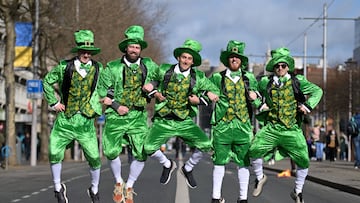ST PATRICK'S DAY
How long does the Chicago River stay green? Any possible environmental consequences…
The Chicago River has been dyed bright green to commemorate St Patrick’s Day since 1961. But is it safe?

A stretch of the main river in downtown Chicago will turn bright green later today to mark the start of the city’s St. Patrick’s Day celebrations. Members of the Chicago Journeymen Plumbers Local 130 will take to the waterway in a fleet of boats at 10 a.m. to pump gallons of a special dye into the water, temporarily turning it a lush, emerald green rolling river while the city’s Irish-American population party, celebrating their patron saint.
Chicago’s Irish community
Chicago has a sizable community of Irish-Americans - some estimations claim it is more densely populated than Boston’s. According to the latest US census, around 8% of Chicago’s 2.5 million population is of Irish ancestry.
The tradition of dying the river green goes back 63 years but the first time the Chicago River took on a green hue was completely accidental. In 1961, Chicago Journeymen Plumbers Local 130 poured a special, oil-based fluorescein dye into the river as a means of detecting leaks and other abnormalities such as illegal chemical pollution. By chance, plumbers union leader Stephen Bailey noticed that one of the worker’s overalls were stained green from the dye. Since then, turning the Chicago River green on the last Saturday leading up to St Patrick’s Day has become an annual event.
Does the green dye present health consequences for the river, drinking water and wildlife?
Chicago plumbers stopped using fluorescein in 1966, switching to a vegetable-based powder, dubbed Leprechaun Dust. Its effect only lasts two days and its low concentration and quick absorption make it non-toxic.
The chemical dye used to turn the river green is not actually green itself but more of an orange color which turns green when it reacts with water. Its formula is kept secret and is not in the public domain but the plumbers union claim that the dye is innocuous and has no harmful effects on the wildlife that inhabits the Chicago River (including several species of fish) or the city’s drinking water. To quote state marketing organization Choose Chicago: “Their environmentally friendly dye formula remains a closely kept secret”.
The Illinois Environmental Protection Agency (EPA) has been closely monitoring the city’s waterway system since the 1970s and publishes an annual report of its analysis. The most recent report did not detect any polyfluorinated substances (PFAs) or perfluorooctane sulfonates (PFOS) - at least if any traces were found, they were negligible. In Illinois, PFAS is more likely to be present in groundwater than surface water. The EPA also takes samples to monitor levels of other potentially harmful or carcinogenic substances, including Chromium-6.
Not everyone is happy about Chicago’s waterways going green for St Patrick’s. Some environmental bodies such as Network in Canadian History & Environment (NiCHE) argue that dying the river is sending out the wrong message to Chicagoans and “perpetuates the notion that we can modify rivers to suit our tastes with no regard to the consequences”.





